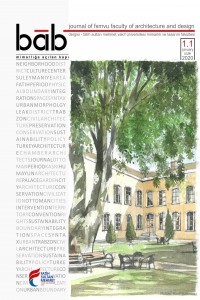Eskizin Üretim Yolculuğunu Sözel ve Görsel Temsil Katmanları Üzerinden Okumak
Eskizde katmanlılık, tanımlayıcı bilgi düzeyi, kavramsal ifade, anlatısal ifade, görsel ifade
Reading the Journey of Sketch Production through the Layers of Verbal and Visual Representation
Layering in sketching, descriptive information, conceptual expression, narrative expression, visual expression,
___
- BELARDI, P., 2016. Mimarlar neden hala çiziyor? Çev: A. EROL. İstanbul: Janus Yayınları.
- BERGER, J., 1986. Görme biçimleri. Çev: Y. SALMAN. İstanbul: Metis Yayınları.
- HOLL, S., 2001. Parallax. Basel: Princeton Press.
- LASEAU, P., 2001. Graphic thinking for architects & designers. Canada: John Wiley & Sons, Inc.
- PALLASMA, J., 1996. Tenin gözleri. Çev: A. U. KILIÇ. İstanbul: YEM Yayınevi.
- SHEER, D. R., 2014. The death of drawing: Architecture in the age of simulation. London: Routledge.
- SOYGENİŞ, M., 2017. Visioning architecture: The sketches of Murat Soygeniş. Rome: Aracne Editrice.
- ŞAHİNLER, O. VE KIZIL, F., 2004. Mimarlıkta teknik resim. İstanbul: Yapı Endüstri Merkezi Yayınları.
- ERBAŞ, F., 2020. Sinemada mimarlık: Büyük Budapeşte Oteli. İçinde: H. T. AKARSU, N. ERDOĞAN ve ÖZBURSALI, T., ed. Sinemada mimarlık. İstanbul: Yapı Endüstri Merkezi Yayınları.
- ASAR, H. ve DURSUN ÇEBI, P., 2018. Mimari temsilde kişisel anlatılar: Karışık yapılı temsiller ve dillendirdikleri. TMD Uluslararası Hakemli Tasarım ve Mimarlık Dergisi. (14), s. 118-143.
- GOLDSCHMIDT, G., 1994. On visual design thinking: The vis kids of architecture. Design Studies. 15 (2), s. 158-174.
- GOLDSCHMIDT, G., 1991. The Dialectics of Sketching. Creativity Research Journal. 4 (2), s. 123-143.
- KONDAKCI, E. ve TONG, H., 2021. Mimari tasarımın erken evrelerinde tecrübenin ve eskiz yapmanın tasarım üretklenliğine etkisi. Journal of Computational Design. 2 (1), s. 95-136.
- MIYAKE, N. ve HATANO, G., 1991. Socia-cultural Constraints and Beyond. Advances in Japanese of Cognitive Science. (4), s. 105-131.
- SUWA, M., ve TVERSKY, B., 1997. What do architects and students perceive in their design sketchs? A Protocol Analysis. Design Studies. 18 (4), s. 385-403.
- SHAH, P. ve CARPENTER, P. A., 1995. Conceptual limitations in comprehending line graphs. Journal of Experimental Psychology General. 124 (1), s. 43-61.
- TVERSKY, B., 1999. What does drawing reveal about thinking? USA: Stanford University.
- GRAND BUDAPEST HOTEL. 2014. Yöneten: Wes Anderson. Almanya-ABD: Wes Anderson.
- Yayın Aralığı: Yılda 2 Sayı
- Başlangıç: 2020
- Yayıncı: Fatih Sultan Mehmet Vakıf Üniversitesi
Mimarlik Mesleğine Kabul Süreci: Türkiye için bir Model Önerisi
Hande NALÇAKAN ÖZKAN, Ayfer AYTUĞ
Zeynep GÜLEL, Burçin Cem ARABACIOĞLU
Eskizin Üretim Yolculuğunu Sözel ve Görsel Temsil Katmanları Üzerinden Okumak
Gizem Nur ŞAN, Lütfiye YILMAZ, Selin YILDIZ
Kültür Varlıklarının Müzeleştirilmesi Üzerine
Mimarlıkta Bulanıklaşan Sınırlar: 2000 Sonrası Yapılar Üzerinden Bir İnceleme
Aslı YÜCEL, Hande DÜZGÜN BEKDAŞ
